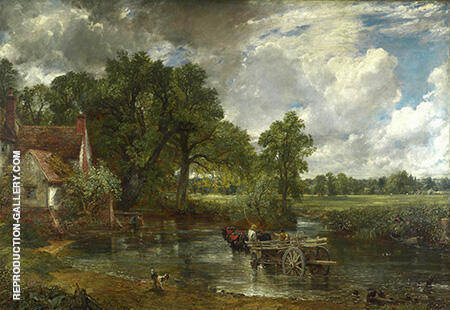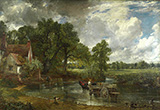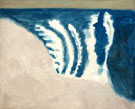The Hay Wain 1821 By John Constable
John Constable, the Hay Wain is the third of three large landscape paintings exhibited at the Royal Academy. This Exhibition marked the zenith of Constable’s painterly skill and provided a unique representation of the Suffolk landscape, now familiarly known as Constable country.
When Did John Constable Paint The Hay Wain?
Painted in 1821, John Constable's The Hay Wain is one of the most famous landscape oil paintings in the entirety of British art. It represents the River Stour, passing through the rural fields of Suffolk where Constable grew up.
The view itself shows the millpond at Flatford. Home to a watermill leased and operated by the Constable family, it primarily ground corn. Indeed, the mill still survives today (located a mile from East Bergholt, Suffolk) and is a tourist destination in its own right.
In Turner’s image, however, the mill itself isn’t visible. Instead, the building to the left of the composition is the house next to the mill, which also survives.
During Constable’s lifetime, a woman named Willy Lott leased the cottage from the Constable family.
Why Did John Constable choose this composition?
Amongst paintings by John Constable, The Hay Wain was a particularly personal composition. He knew the view incredibly well, having grown up in the area.
The title refers to a wagon (wain) used for transporting animal foods like cut grass (hay) for winter. However, small details reveal Constable’s intense personal connection with the landscape.
Indeed, the wagon’s front wheel already turns right. The cart is ready to cross the ford and reach the meadow on the other side. The haymakers themselves are also hard at work. One sharpens his scythe while another farmhand pitchforks hay into a wain in the distance.
Surprisingly to many viewers, John Constable painted this landscape oil painting, and many of his other artworks, in his London Studio. In addition, Turner made numerous drawings, oil, and pencil sketches of Willy Lott’s farmhouse over his lifetime.
He consequently painted the scene primarily from memory and his existing sketchbooks. Constable added details (such as the small boat on the right-hand side) to balance the composition rather than historical accuracy.
What is the Historical Context of The Haywain?
The Hay Wain represents a changing way of life. In the early nineteenth century, the Industrial Revolution was taking hold in Britain.
Traditionally, much of the rural poor worked in agriculture. However, this rapidly shifted with factories springing up in towns and cities. Steam power, locomotives (such as those painted by Turner), and cotton mills replaced traditional horses, carts, and days in the fields.
As a Suffolk youth, Constable would intimately witness these social, economic, and cultural developments.
In terms of artistic context, carts traveling through fords commonly appeared in seventeenth-century Dutch landscape art. John Constable particularly admired these paintings. In addition, he owned two landscapes by Jan van Goyen which both referenced travelers in carts.
Constable also studied the painting of Peter Paul Rubens. The Hay Wain's overall composition and the cart's unusual shape consciously emulate many elements in Ruben's art.
Where is Constable’s original painting?
Today, The Hay Wain hangs in the National Gallery of London.
Although Constable’s masterpiece was well-reviewed on its debut, it failed to sell. This deeply disappointed Constable, who later sold the portrait as part of a collection to a dealer for £250.
Accompanying The Hay Wain were the paintings Stour Valley and Dedham Church, and Yarmouth Pier. The dealer subsequently sent the paintings to Paris and the 1824 Salon, where they became somewhat of a cause célèbre.
Commenting on the painting’s eventual success, Constable humorously remarked on the “peaceful farmhouses of Suffolk,” causing a scene among the “gay and frivolous” Parisians.
While the painting initially found favor in France but a lackluster reaction in Britain, the tables have now turned. Today, The Hay Wain is a celebration of one of the most iconic depictions of rural England.
We offer a 100% money back guarantee or replacement service. If for any reason you are dissatisfied with your painting please contact us within 7 days of receipt, advising the reason you are unhappy and we will provide you with all the information you need for its return or replacement.
We ship free to anywhere in the world via FedEx or DHL expedited service with online tracking.
Your painting will be shipped rolled in strong plastic tubing, ready for stretching and/or framing locally. This is the conventional method of transporting hand-painted oil on canvas. Learn more about how your painting is shipped.
We are able to offer a framing service intercontinental U.S. Please contact us if you would like a quotation. Alternatively, should you prefer, we can recommend a framer in your area.
Notes About Your Painting
Please note that replica oil paintings are finished with an additional 10cm (4") of extra canvas on all sides, allowing ample surplus canvas for stretching and framing.
Cannot Find What You Are Looking For?
Reproduction Gallery Information
Customer Service
(Send Us A Message)
Tel: (503) 937 2010
Fax: (503) 937 2011








